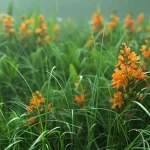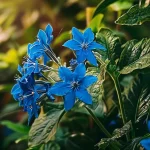Arum plants, with their distinctive bract and bulb structure, have long been a staple in both European and African gardens. If you’re seeking to breathe new life into your landscape with these elegant plants, you’re in the right place. This guide unpacks various arum varieties and offers tailored care tips to ensure they thrive. From choosing the ideal plant to tackling cultivation challenges, we’ll pave your path to a lush garden. You’ll discover not only how to plant and nourish your arums but also how to address common issues they may encounter. Let’s unfold the secrets to transforming your garden with the charm and grace of arums.
Table of Contents
ToggleIntroduction to Arum Plants

Welcome to the diverse world of Arum plants, a family rich with history and boasting a variety of species, including the renowned anthurium. Reflecting on the past, I’m intrigued by their historical role, while the soil requirements and tuber-based nature underscore their botanical uniqueness. Originally from regions like Indonesia, these plants offer more than aesthetic appeal—they are a study in adaptability and resilience. In the upcoming sections, I will guide you through understanding their family ties, their importance throughout history, and the distinctive characteristics that make Arums a favorite among plant enthusiasts.
Understanding the Arum Family
The Arum family, known scientifically as Araceae, encompasses a wide array of plants, with Arum italicum as a species often found gracing botanical gardens. As a professional with a keen interest in botany, I’ve observed that these perennial herbs are marked by their distinctive foliage and intriguing flower spathes, which have captivated plant lovers for centuries. These features not only contribute to their popularity but are also significant from a botanical perspective.
In my experience, one cannot discuss Arum without addressing the peculiar chemical compound dimethyl trisulfide. This sulfur-containing substance is notable for its role in the pollination process of plants such as Arum maculatum, where it emits a distinct odor to attract specific pollinators. Such fascinating evolutionary adaptations demonstrate the complexity within the Arum family and form an integral part of my discussions when I lead educational walks in gardens.
Despite the beauty of the Arum family, it’s important to note the presence of oxalate crystals in these plants, a defense mechanism that can cause discomfort if mishandled. In my years of advising gardeners, I’ve underscored the necessity of handling all Arum species with care, reminding them of the potential irritation these crystals can cause. Knowledge of such details is crucial for anyone looking to cultivate or work closely with these plants, ensuring both safety and appreciation for their unique botanical characteristics.
Historical Significance of Arum Plants
In my professional exploration of Arum plants, I’ve come to appreciate their historical significance which is as rich as their biological diversity. Of particular note is the titan arum, which stands as a symbol of botanical wonder and has a history of astonishing onlookers with its massive bloom and intense fragrance. This species has garnered worldwide attention, underpinning its control over the conversations among plant enthusiasts and botanists alike due to its rare and dramatic flowerings.
Additionally, my engagement with the historical aspects of these plants has revealed their intersection with human culture. For instance, the Rafflesia arnoldii, which belongs to a related family but shares some habitat with Arum species, has been a cultural icon in regions like Indonesia, illustrating the deep ties these plants have with local histories and mythologies. Understanding these connections encourages a deeper appreciation and informs conservation efforts, ensuring that such unique species continue to astound future generations.
Lastly, delving into the historical use of Arum plants, I’ve identified that certain species have been employed for their unique properties in various applications. Historically, their impressive control over their temperature during blooming, a phenomenon known as thermogenesis, has intrigued scientists and laypersons alike. This trait, alongside their resilient nature, makes them a subject of continual study in a world seeking sustainable biological solutions and insights into plant adaptability and survival strategies.
Unique Characteristics of Arums
Arums distinguish themselves in the botanical world through their unique pollination strategy, which often encompasses the intriguing use of heat to attract insects. In the depths of an arboretum, I have witnessed the thermogenic prowess of these plants as they generate warmth, a phenomenon drawing pollinators that mistake the bloom for decomposing organic matter. It’s a fascinating display of symbiosis between flora and fauna, showcasing the intricate relationship within ecosystems across regions such as North Africa and beyond.
Handling Arum plants requires a careful touch, as the skin can react to the oxalate crystals within their tissues. During my tenure advising at a prominent arboretum, I’ve educated numerous enthusiasts on the proper handling of Araceae species to prevent any discomfort or skin irritation. This knowledge is indispensable, especially to those passionate about introducing the exotic allure of Arums into their own green spaces.
Arum plants possess incredible adaptability, with many species, including those from North Africa, thriving in a range of environments from shaded woodlands to sun-kissed clearings. My personal observations have revealed that their resilience is partly due to their storage organs, allowing them to endure various climatic challenges. This remarkable trait provides key insights to gardeners and conservationists alike, aiming to cultivate and preserve the biodiversity of Araceae family plants.
Arum plants command attention with their bold foliage and mysterious blooms. Now, let’s meet the array that gives this family its renowned diversity.
Popular Varieties of Arum Plants

In my guide, we turn our attention to notable Arum species, such as Italian Arum (Arum Italicum) and Lords-and-Ladies (Arum Maculatum), alongside charming Cuckoo Pint varieties. I will highlight what makes these plants thrive, from the rainforest origins of Amorphophallus titanum to the ideal calcium-rich soil for healthy growth. Understanding your garden‘s hardiness zone is pivotal in choosing the right Arum. I’ll share insights to ensure you make an informed selection, fostering a flourishing garden space.
Italian Arum (Arum Italicum)
Italian Arum, or Arum Italicum, is a perennial valued for its elegant foliage and the striking berries that emerge after flowering. During my own cultivation efforts, I’ve observed that these berries, while adding visual interest during winter, are also an important consideration for the local ecosystem as they can be toxic when ingested. Awareness of this can help prevent gardening enthusiasts from making unintended negative impacts, particularly if these plants are grown in areas accessible to children or pets.
In my professional experience, I pay careful attention to the growth pattern of Arum Italicum as it has been known to behave as an invasive species in some climates. This determination, which I’ve seen firsthand, can lead to its dominating local flora if not managed properly. Enthusiasts should practice diligent control measures, such as removing fruit before seed dispersal, to mitigate its spread and respect the surrounding ecological balance.
The dormancy period of Arum Italicum presents a remarkable adaptation; the plant retreats into a rest phase during the summer, conserving energy until the cooler months. As a botany consultant, I advise clients to reduce watering during this dormancy and prepare for a reduction in visible growth. This understanding of the plant‘s natural cycle is crucial for ensuring its vibrant resurgence in the autumn, allowing for continuous enjoyment throughout the changing seasons.
Lords-and-Ladies (Arum Maculatum)
Lords-and-Ladies, known scientifically as Arum Maculatum, is a striking plant commonly found in Europe‘s woodlands and hedge rows. In my experiences with this species, I’ve found that its hooded flowers and glossy berries are a source of curiosity due to their seductive allure to insects, while providing the nectar that is so vital for pollination. Gardeners value this plant for the intriguing addition it makes to shaded garden areas, however, they should be cautious as all parts of the plant can be toxic if ingested.
The growth requirements for Arum Maculatum are not overly demanding, which I appreciate as it allows even amateur gardeners to enjoy its striking appearance without intensive maintenance. This plant thrives in moist, fertile soil that mimics its natural woodland habitat, and while it enjoys the dappled sunlight, it’s quite capable of flourishing in darker corners when adequately watered, especially during dry spells when rain is scarce. My practical advice to cultivators is to ensure consistent soil moisture without waterlogging the plant.
In comparison to their tropical cousin, Amorphophallus titanum, or the corpse flower, Lords-and-Ladies are vastly more manageable in temperate climates. Both species share a remarkable ability to heat their spadix during flowering, which aids in spreading their scent to attract pollinators. While managing Arum Maculatum in a garden setting, I’ve observed that they do not require the high humidity of their rainforest-relative, making them a suitable and exotic addition to a wider variety of garden environments.
Cuckoo Pint Varieties
The Cuckoo Pint, also known as Arum maculatum, is a notable variety within the Arum genus, esteemed for its robustness in various landscape settings. As a perennial, it resurfaces yearly to display its unique hooded flowers and leaves, often mottled with distinctive patterns. In guiding gardeners on its cultivation, I emphasize its ability to provide a touch of woodland charm to garden spaces, adapting well to temperate climates.
In my professional observations, the Cuckoo Pint’s flower structure is exceptionally adapted to attract and trap the specific pollinators required for its reproduction. The plant emits a faint odor that lures insects deep inside its spathe, aiding effectively in seed pollination. This intricacy of pollinator attraction is a point I stress when educating enthusiasts—it’s an exquisite, if subtle, dance that underpins the success of the species within the ecosystem.
Although Cuckoo Pint thrives with minimal intervention, I advise gardeners to sow its seeds in shaded areas, keeping in mind that its berries can be attractive yet toxic if ingested. My goal is to help cultivators strike the delicate balance between enjoying the natural beauty of these unique plants and maintaining safety in their gardens. With the correct care, this variety can be a captivating, low-maintenance addition to perennial collections.
Selecting the Right Arum for Your Garden
When I consider integrating Arum plants into the horticultural tapestry of a garden, I pay careful attention to each variety’s individual demands. For instance, certain Arums originating from Asia require a habitat that mimics their indigenous climate—humid and warm. Before choosing an Arum, I assess the garden’s exposure to sunlight, soil type, and moisture levels to ensure the right fit which will foster the plant’s growth without excessive maintenance or the risk of it dominating other flora.
In my professional experience handling Arum plants, I’ve witnessed cases where irritation from pollen or the sap led to discomfort for the unwary gardener. It’s imperative to understand the safety precautions required when cultivating Arums. I always recommend wearing gloves when handling these plants to minimize skin irritation and ensure a pleasant horticultural experience. It’s these practical insights that I share with enthusiasts aiming to enjoy the beauty of Arums without any unintended consequences.
Given the diverse array of Arum species, selecting the right one for your garden can be akin to finding the perfect piece for a botanical puzzle. Reflecting on the desired visual impact, considering whether the lush foliage of Arum italicum or the enigmatic blooming of Amorphophallus would suit the space better is key. I always remind fellow gardeners to study the native habitats of their chosen Arum, from the Mediterranean environs to the tropical climates of Asia, to replicate these conditions as closely as possible for a thriving garden centerpiece.
Knowing the right arum to choose is one step. Planting them with skill seals their success.
Planting Arum Plants Successfully

Transitioning from the fascinating characteristics and historical significance of Arum plants, we now delve into the practical aspects of planting them successfully. Selecting an ideal location requires understanding the preferences of this diverse genus, from woodland shadows to sunlit patches, ensuring the thriving of these perennial favorites. We’ll explore preparing the soil with care, considering optimal pH levels and the strategic use of herbicides to avert unwelcome plant competition. I’ll share insights into planting techniques and timing, crucial for syncing with the natural growth cycles of Arums, as well as thoughtful approaches to companion planting that can boost local pollinator populations and enhance corm health. These practices will ensure your Arums not only grow but flourish in their new home.
Choosing the Ideal Location
When I set out to plant Arum plants in my garden, the priority is always to find a locale that simulates their native habitat as closely as possible. For many Arums, such as the intriguing Arisaema with its showy spadix, a spot with dappled light or partial shade is often ideal. The soil here should be well-draining yet moisture-retentive – a balance that’s critical for these ornamental plants to avoid the root rot that can occur with stagnant water, while ensuring they receive the hydration they need.
In my professional understanding, Arum species like Zantedeschia, also known as calla lilies, are slightly more forgiving with light exposure and can tolerate a brighter setting. However, it’s key to note that the presence of calcium oxalate within the Arum family means that garden placement should also consider safety. Choosing a location away from high-traffic areas minimizes the risk of accidental ingestion by pets or curious children, promoting a safe coexistence with these beautiful, albeit hazardous, plants.
Understanding the specific needs of each Arum plant guides me to select a location that maximizes its health and ornamental value. For example, the deep greens and purples of the spadix are enhanced when placed against a background that allows the colors to pop. The location I choose purposefully takes into account the interplay of light and shadow throughout the day, ensuring the spadix and leaves receive the spotlight they deserve, and the plant healthy growth by meeting its fundamental light and soil requirements.
Preparing the Soil for Arums
When I look to assimilate a herbaceous plant like the Arum into my garden, prioritizing soil preparation is essential. Arums, with their roots in the rich tropics of regions such as Sumatra, favor a soil environment that is both fertile and well-drained. Drawing from this biodiversity hotspot, I enrich the ground with organic matter, ensuring it can hold adequate moisture without becoming waterlogged—a fine balance that mimics their native, nutrient-rich soils.
My approach in cultivating a suitable setting for Arum plants includes adjusting the soil pH to align with their preference for slightly acidic to neutral ground. This step is crucial, as the proper pH not only facilitates the uptake of essential nutrients but also can affect the release of aromatic compounds like dimethyl disulfide, which is significant for pollination. I’ve found that incorporating elements such as peat or pine needles can naturally moderate soil acidity, creating an ideal condition for these stately plants.
I have learned through experience that while Arums are adaptable, the vitality of their blooms is often tied to correct soil preparation. To ensure robust growth, I routinely test the soil before planting to tailor my additions—compost for structure, bone meal for phosphorus boost, or sand to improve drainage. This pre-planting ritual lays the groundwork for a thriving Arum display, reflecting my commitment to replicating the lush and diverse habitats from which they originate.
Planting Techniques and Timing
To ensure the successful establishment of Arum plants, I advocate for careful consideration of both planting techniques and timing. Arum’s impressive inflorescence is best supported by soil that’s been methodically prepared to accommodate the plant‘s root system—typically dug to a depth equal to that of the pot or the tuber if planting directly into the ground. Nestling these plants at the correct depth in the soil is crucial; I aim for just below the surface for smaller tubers and a few inches down for larger ones, ensuring the top of the tuber sits within reach of adequate sunlight and air.
Timing is pivotal when transplanting Arum plants, as they enjoy a growth cycle that’s sensitive to seasonal changes. I’ve found optimal results occur when I plant the tubers in fall, which allows them to establish a strong root system during the cool months. This schedule leads up to a robust growth spurt in the spring when the leaf development is energetically pursued. It’s a strategy embracing the natural rhythms of these plants, aligning gardening efforts with the cycles that dictate their flourishing.
Once planted, maintaining the right balance of sunlight and shade contributes to the strength of the leaf and inflorescence. I have discovered that Arum plants benefit from a position where they receive filtered light, replicating the canopy-like environment that promotes vigorous growth. Assessing my garden‘s lighting conditions, I position the plants to receive the morning sun while being shielded from harsh afternoon rays, syncing their growth with the light patterns that define their natural habitats.
Companion Planting With Arums
In my professional practice of gardening, I’ve observed that companion planting can significantly enhance the health and display of Arum plants. By carefully choosing neighboring plants that offer shade or ground cover, we can create a symbiotic environment that mimics the understory of their natural woodland habitats. Ferns and hostas, for instance, provide ample cover for Arums, helping maintain soil moisture while also adding textural contrast to the garden.
Additionally, I consistently recommend the integration of flowering plants that bloom at different times to extend the garden’s visual appeal beyond the Arum’s blooming period. Pollinator-friendly companions like lavender or salvia not only promote a healthy garden ecosystem by attracting beneficial insects, but they also keep the visual interest alive in the garden, ensuring a seamless transition of color and form.
My experience has taught me that practising companion planting with Arums can contribute to their overall growth and vigor. Assistance from neighboring plants in warding off common pests, through natural repellence or by drawing them away from the Arums, can be invaluable. Over the seasons, I have found that strategic companion planting results in a more resilient and vibrant Arum display, bringing out the best in the genus’s remarkable foliage and flowers.
Your arum plants are in the ground, their roots settling into the earth. It’s time now to tend and watch them thrive.
Caring for Your Arum Plants

Having explored the diverse Arum varieties suitable for your garden, I’ll now walk you through essential care practices to ensure healthy growth and stunning displays. In this section, we dive into efficient watering techniques, fertilization recommendations tailored for Arums’ needs, strategic pruning for optimal plant health, and overwintering methods to protect these perennials through the colder months. Each of these aspects plays a pivotal role in nurturing your Arum plants, contributing to a vibrant garden year after year.
Watering Practices for Healthy Growth
In my horticultural pursuits, I’ve learned that proper watering is crucial for the vitality of Arum plants. These species favor consistently moist soil, replicating the conditions of their natural habitat, without becoming saturated. Through attentive monitoring, I ensure the ground is damp to the touch—a sign of adequate hydration—but not waterlogged, which could lead to detrimental root rot.
Seasonal fluctuations present a particular challenge that I navigate with thoughtful adjustments to watering schedules. During the active growing season, I increase the frequency of watering to support the energetic development of leaves and flowers. Conversely, in their dormant periods, I diminish the frequency, allowing the soil to dry somewhat more between watering sessions, a shift that accommodates their reduced hydration needs.
My practical experience has revealed the importance of tempering irrigation methods based on weather conditions and natural rainfall. Overhead watering on sunny days, for instance, can subject the leaves to scorching, so I prefer early morning or late afternoon watering, which reduces evaporation and sun damage. This approach provides the Arum plants with the continuous moisture they require for healthy growth while safeguarding their delicate foliage.
Fertilizing Tips for Arums
As a keen grower of Arum plants, I have found that fertilizing plays a significant role in promoting vigorous growth and vibrant blooms. My approach involves applying a balanced, slow-release fertilizer at the beginning of the growing season, which provides a steady supply of nutrients. This method supports gradual uptake by the roots, enhancing the overall health and resilience of my Arum collection.
In my experience, careful attention to the composition of fertilizers specific to Arum plants is necessary. I opt for products that are rich in phosphorus to encourage healthy root development and flourishing flowers. The right fertilizer blend will nourish the plants without overwhelming them, aligning with the delicate balance of their natural growing conditions.
Throughout the growth cycle of my Arum plants, I’ve learned the importance of reapplying fertilizer, particularly when the plants show signs of active growth or preparing to bloom. A light feeding during these critical phases invigorates the plants, often leading to an impressive display of foliage and flowers that captures the eye and compliments the garden’s aesthetic.
Pruning and Maintenance Guidelines
In my gardening practice, I consider pruning an indispensable aspect of Arum plant maintenance, aimed at keeping these perennials healthy and aesthetically pleasing. Removing spent blooms and yellowing leaves not only tidies the plant but also redirects energy towards growth and future flowering. This ongoing attention to pruning ensures that my plants retain their vigor and display their full ornamental potential each season.
My approach to caring for Arum plants includes a systematic assessment of their foliage and stems, watching for any signs of damage or disease. By regularly inspecting and trimming away afflicted areas, I prevent potential problems from spreading. This simple yet effective routine maintenance upholds the structural integrity of the plants and contributes to a well-manicured garden display.
As the growing season draws to a close, I turn my focus to preparing Arum plants for dormancy. I trim back foliage after it has died down naturally, facilitating a tidy area and reducing the likelihood of fungal growth. This proactive step, based on my understanding of the Arum life cycle, is a fundamental practice that aids in protecting the plants during their less active phase and setting the stage for their resurgence in spring.
Overwintering Strategies for Arums
In managing the overwintering of Arum plants, I’ve observed that their resilience is enhanced significantly by mulching. Applying a generous layer of organic mulch around the base not only insulates the soil, moderating temperature fluctuations, but also provides nutrients as it decomposes. This method remarkably improves the plant‘s chances of withstanding the cold months, especially in regions where the temperature dips below their tolerance levels.
For some Arum species, particularly those with tropical origins, overwintering indoors can be an efficient strategy. I have successfully overwintered Arum plants by digging up their tubers after the foliage dies back and storing them in a cool, dry place. Sheltering these tubers from the harsh outside climate preserves their vitality, readying them for replanting when the warmth of spring returns.
Even with hardier varieties, such as the Arum Italicum which can usually handle colder temperatures, I take a proactive stance by ensuring proper drainage before winter arrives. Saturated soils during freezing conditions can be fatal for the tubers. I make necessary adjustments to the garden‘s layout, often improving soil structure or altering the landscape slightly to prevent water from accumulating around the plants, securing their survival through the winter.
Tending to your arum plants is just the start. Challenges arise, hard and fast as the arum grows.
Dealing With Common Arum Challenges

Navigating the challenges associated with Arum plants is crucial for gardeners. I’ll provide insights into effectively managing pests and diseases, ways to mitigate invasiveness concerns, and how to handle the toxicity of these plants safely. Additionally, I will offer solutions for troubleshooting common growth issues. These targeted discussions will equip you with the knowledge required for maintaining healthy and vibrant Arums.
Managing Pests and Diseases
In my professional experience, Arum plants are susceptible to common pests such as spider mites and aphids, which can be detrimental to their health. To manage these pests, I regularly inspect my plants, particularly under leaves and around the flower spathes, where these insects tend to congregate. Prompt identification and treatment with appropriate insecticides or natural predators like ladybugs facilitate effective pest control.
When it comes to diseases, I’ve observed that Arum plants are prone to fungal infections, particularly when the leaves are subjected to excessive moisture. By adopting good watering practices, such as watering at the base rather than overhead, I’ve successfully reduced the occurrence of these infections. Additionally, ensuring good air circulation around plants helps mitigate the risks of diseases taking hold.
Dealing with root rot is another challenge I’ve faced with Arums, often brought on by waterlogged soil conditions. The key to preventing this destructive disease is providing well-draining soil and being cautious not to overwater. If signs of root rot appear, such as yellowing leaves or a foul smell from the soil, I take immediate action by removing affected parts and amending the soil to improve its structure and drainage capabilities.
Addressing Invasiveness Concerns
In my professional gardening practice, it’s become clear that certain Arum plant species can become invasive, quickly outcompeting native flora. I urge gardeners to research the specific growth patterns of their chosen Arum variety and to be proactive in controlling its spread. Regularly removing seed heads before they disperse and restricting the root space with barriers are practical measures that can effectively keep invasiveness in check.
Engaging with local horticultural societies has also provided me with valuable insights into non-invasive Arum cultivars that are suitable for domestic gardens without posing ecological risks. I always recommend these alternatives to gardeners concerned about the environmental impact of their planting choices, thus promoting a harmonious balance between ornamental gardening and native biodiversity conservation.
My experience has taught me that diligent monitoring and management are key to preventing the aggressive spread of invasive Arum species. Cultivating these plants in containers or raised beds is a strategy I’ve implemented to create a barrier to unchecked growth. By containing their rhizomes, we ensure these captivating plants enhance our gardens without disrupting the surrounding ecosystem.
Safety Considerations Due to Toxicity
As I guide enthusiasts in cultivating Arum plants, I stress the significance of understanding their toxicity. These plants contain calcium oxalate crystals, which can be harmful if ingested or even cause skin irritation upon contact. It’s imperative that I inform gardeners to establish their Arums away from areas frequented by children and pets, and to handle them with gloves, ensuring a safe and enjoyable gardening experience.
In my professional role, I’ve encountered cases where the allure of Arum plants’ vibrant berries and flowers has led to accidental ingestion, resulting in discomfort and medical concerns. It’s a priority for me to underline the importance of educating family members, especially the inquisitive minds of young ones, about the potential risks associated with these otherwise enchanting plants.
Adding further to safety practices, I advise on the proper disposal methods for pruning Arum plant materials. Ensuring that trimmed leaves and stems are kept out of reach of both pets and wildlife helps prevent unintended harm. My goal is to empower those I assist with the knowledge to handle these beautiful plants responsibly, maintaining a secure environment for all who enjoy the garden.
Troubleshooting Growth Issues
In my years working with Arum plants, stunted growth has often pointed towards poor soil conditions. To address this common growth issue, I assess the soil‘s texture, nutrient content, and pH. If the soil is too compact, adding organic matter can improve drainage and airflow, which are vital for the Arum’s roots to develop properly.
If an Arum plant‘s leaves are fading or exhibiting a weak appearance, I typically suspect inadequate lighting or nutrient deficiencies. Arums are fairly adaptable but still require specific light conditions and nourishment to thrive. By adjusting their placement to an area with indirect, filtered light, and supplementing with a balanced, slow-release fertilizer, I usually see a return to vigorous health.
Pesky pests like aphids and spider mites often target Arum plants, causing visible damage and inhibiting growth. From my experience, a regular inspection regime paired with prompt treatment, including the use of organic insecticidal soaps or neem oil, effectively mitigates these issues. Encouraging natural predators, such as ladybugs, into the garden can also provide a long-term, sustainable solution to maintaining Arum plant health.
With patience and the right tactics, you’ve overcome the challenges that face arum plants. Now, let’s turn our focus to the promise of beauty these robust bloomers will add to your landscape.
Enhancing Your Landscape With Arums

Turning our focus to the aesthetic integration of Arum plants into your environment, we explore their application in garden design, container gardening, harmonious pairings with other plants, and their capacity to entice wildlife. Each topic is steeped in practical insights aimed at maximizing the visual and ecological benefits that Arums offer. We’ll delve into crafting landscapes that reflect both beauty and functionality, ensuring these versatile plants elevate your outdoor space.
Designing Gardens Featuring Arums
In designing gardens that showcase Arum plants, I prioritize visual balance and harmony. Integrating Arums, with their bold spathes and lush foliage, I place them where they become focal points, drawing the eye and accentuating their unique forms. This is often among lower-growing companion plants, which serve to highlight the Arums without overshadowing them.
I’ve found that creating contrast is key in garden design, and Arums offer ample opportunity for this with their varied textures and colors. When positioning Arum plants, I consider their surrounding environment, ensuring that their deep greens and vibrant spathes complement the overall color scheme and texture profile of the garden, whether they are placed against a backdrop of fine ferns or nestled among broad-leaved hostas.
Throughout my experience, I’ve also recognized the importance of plant placement in relation to sunlight. While many Arum varieties thrive in partial shade, I ensure that they receive the right amount of light to not just survive, but prosper, resulting in a dynamic garden where Arums serve as stunning testament to the beauty of nature’s diversity.
Arums in Container Gardening
My experience with container gardening has revealed that Arum plants are remarkably well-suited for this practice, given their contained root system and striking aesthetic. When selecting containers for these plants, I ensure adequate drainage to prevent waterlogged soil, which is vital for their health and blooming capabilities. A properly sized pot accommodates their growth while allowing for seasonal changes in soil moisture and temperature.
I’ve found that the ease of mobility that comes with container gardening allows for precise management of the light conditions required by Arum plants. By placing them in areas that receive mild, indirect light, I avoid the risk of excess sun which could damage their intricate leaves and blooms. This careful placement also brings the vibrant colors and unique shapes of Arums into the spotlight, enhancing balconies, patios, or indoor spaces.
Through container gardening, I frequently provide personalized advice on soil composition for Arum plants to thrive. The use of a well-balanced, fertile potting mix ensures the steady supply of nutrients needed for robust growth. I’m mindful to complement the soil with organic matter, such as compost, to maintain the rich structure Arums fondly respond to, facilitating an environment where these plants flourish with minimal intervention.
Combining Arums With Other Plants
When incorporating Arum plants into garden landscapes, I focus on companion planting to enrich diversity and visual appeal. Choosing plants like hostas or ferns, which thrive in similar conditions, creates a textured understory layer that complements the bold spathes and foliage of Arums. This not only caters to aesthetic harmony but fosters an environment where each species supports the other’s growth, much like in their natural ecosystem.
I have found success in combining Arum plants with perennials that offer a variety of bloom times, ensuring the garden remains vibrant across the seasons. Strategic planting of early spring bulbs or late-flowering perennials can bridge the gap when Arums are not in bloom. Thoughtful selection of these companion plants heightens the Arum’s impact, reinforcing the garden‘s continuous display of life and color.
In my gardening experiences, careful selection of companion plants for Arums can also contribute to a well-maintained garden by naturally deterring pests. For example, integrating marigolds or alliums, which are known for their repellant properties, can shield Arums from harmful insects, reducing the need for chemical interventions. This approach aligns with eco-friendly gardening practices, ensuring Arums thrive while maintaining the garden‘s health.
Attracting Wildlife With Arum Plants
Introducing Arum plants into your garden has a dual advantage; their distinctive inflorescences not only add to the visual charm, but also invite a host of local wildlife. I’ve noticed that the unique structure of Arum flowers, especially their warmth and scent, appeal to a variety of pollinators, such as bees and butterflies, turning the garden into a buzzing hub of activity. This attracts natural biodiversity which is essential for maintaining a balanced ecosystem.
In my gardening experience, I have found that the berries produced by Arum plants can also attract birds to the garden. While it’s important to be aware of the toxic nature of these berries to humans and pets, they provide a valuable food source for certain bird species. Creating habitats for wildlife is a passion of mine, and incorporating Arum plants has proven to be an effective strategy in achieving that goal.
When I plan an Arum-rich garden, I consciously think of it as crafting a sanctuary for wildlife. The diverse array of insects that Arum plants attract with their intriguing pollination mechanisms often becomes food for predatory species, which adds layers to the garden‘s ecological web. It’s immensely fulfilling to watch a garden come alive with the flutter and chirp of creatures, enriching the environmental tapestry of the outdoor space.
Conclusion
In closing, Arum plants stand out in the horticultural world for their distinctive beauty, intriguing pollination mechanisms, and ability to attract wildlife, making them a valuable addition to any garden. Proper care, from selecting the ideal location to mastering watering and overwintering techniques, ensures these diverse species thrive and contribute to a vibrant garden ecosystem. Addressing challenges like invasiveness and toxicity with informed practices allows gardeners to safely enjoy the unique allure of Arums. This comprehensive guide equips enthusiasts with the knowledge to cultivate and appreciate the wide array of Arum varieties, enhancing both the aesthetic and ecological value of their landscapes.










